Paint and Post Touch Drills to Improve Your Points Per Possession
Before we get to the drills, you've got to take a look at these mind-blowing offensive stats about Paint Touches...
FYI: Paint Touches are when the ball touches the paint (or a player in the paint)... This could be on dribble penetration, a pass to the paint, or a pass through the paint (skip pass).
Paint Touches = More Points per Possession for the Crimson Tide
Nate Oats, coach of the University of Alabama Crimson Tide, has charted the number of Paint Touches the last two years and discovered this...
Paint Touches have a direct correlation to an increase in Points Per Possession (PPP).
In Brent Tipton's article The Paint Touch, he posted a chart that Oats shared at a conference, which showed the Crimson Tide's half-court offense stats...
Last year, their half-court offense PPP rose as the number of Paint Touches went up:
0 Paint Touches = .88 PPP
1 Paint Touch = 1.6 PPP
2 Paint Touches = 1.26 PPP
3 Paint Touches = 1.5 PPP
Here's a graph showing how Alabama's Points Per Possession increased with Paint Touches (compared to zero Paint Touches):
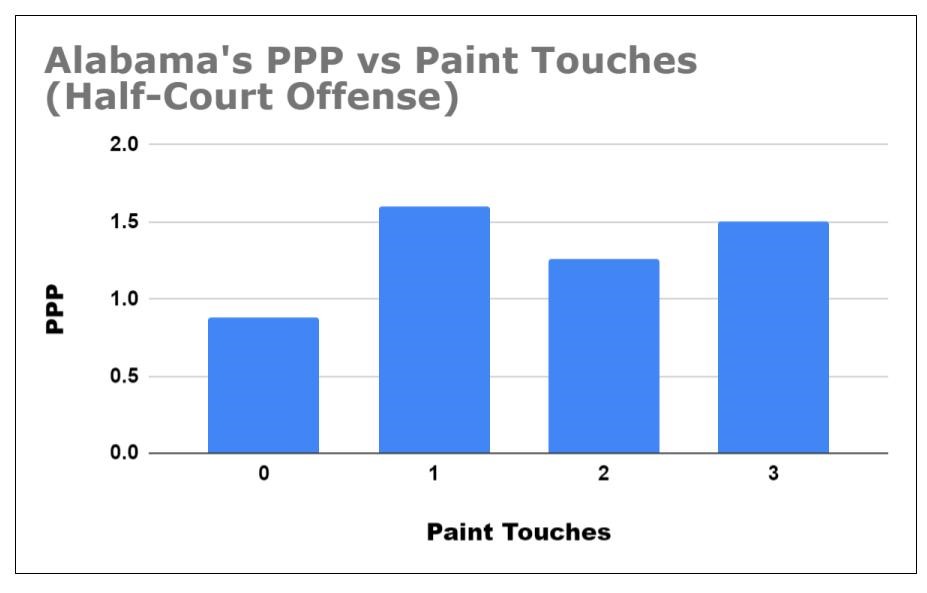
As you can see from the chart, Paint Touches get you more points per possession.
The PPP increased because each Paint Touch created a rim finish or a defensive rotation that opened a space advantage for a catch and shoot 3...
...Which is why Shot Quality rated Alabama as having the best Rim and 3 rate in the nation in 2021. This means that Alabama takes the most shots combined at the rim or from the arc than any other team in the nation...
Oats focuses on getting paint touches - which create the highest percentage shots... finishes at the rim and open jump shots off the kick-out.
Entering his third season last fall, Oats has compiled a record of 42-22 (.656), so those Paint Touches have helped Oats bring some wins to Alabama!
To get FREE 5 Drills to Build Your Motion Offense FAST, click the banner below
Paint Touches Gave Baylor 65%+ Successful Possessions
And there's more proof about the power of Paint Touches...in Coach Sam Patterson's article Ten Stats that Every Basketball Coach Should Track, former assistant at Baylor, also wrote about the results of having those touches:
For half-court possessions, Baylor charted every time the ball touched the paint.
This could be on dribble penetration, a pass to the paint, or a pass through the paint (skip pass).
They wanted 70% of their half-court possessions to include a paint touch before a shot attempt.
During timeouts, they told their players the percentage of successful possessions with a paint touch versus the percentage of successful possessions without a paint touch (This utilizes Pearson's Law of Accountability).
Typically, they were above the 65% range of successful possessions with a paint touch and under the 30% range without a paint touch.
Below you can see Baylor's successful possessions (meaning they scored) went up with at least one Paint Touch:
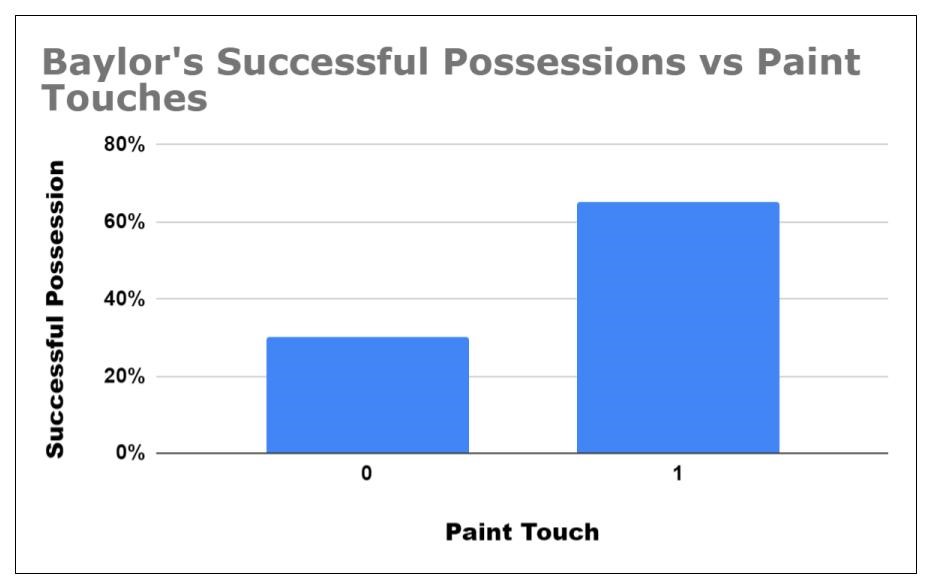
THE MESSAGE: Paint Touches lead to more points scored during a possession...so more points on the board!
Post Touches - One Way to Get a Paint Touch
So one tactic to get a Paint Touch is to pass the ball into your Post...aka - get a Post Touch.
It doesn't mean your Post is going to be the one who scores. Your Post has the option to pass, which creates a ton of high-efficient shots for the rest of the team.
In fact, Villanova did that with Jalen Brunson, who generally played as a guard, but he'd also work the post because he was such a great passer...which created a ton of open shots for his teammates.
And here's some more data for you...Shot Tracker did a mini-study of 12 D1 teams and their Post Touches (and Ball Reversals):
When on offense, if you had zero post touches, your points per possession was a measly 0.706. When you simply added just one post touch per possession, that jumped to 1.061 points per possession.
That means in a 70 possession game, your scoring sky rockets from 49 points per game to 74 points per game!
And if you add in two ball reversals with a post touch... you jump to 1.189 points per game, which would get you to 83 points per game.
Post Touches + Ball Reversals = More Points! - Just look at the study's data in the last row...

Get the Ball into the Post... And Teach Your Players to Move After the Pass (Not Stand Around!)
One of the biggest problems that I see is players standing around after passing, especially into the post.
This is going to ruin the increased PPP that we talked about above because passes out of the post are one of the highest PPP actions in basketball.
Here are some strategies that the Passer can use to create movement and space...allowing more shots to open up.
#1 - Pass & Space - Move to Defender's Back
This strategy is really beneficial for when the passer is a good shooter. After passing, they can move to an open spot. This can be a move from the wing to the corner, wing to the top, corner to wing, corner to top, etc.
Go where your teammates aren't and where you can get open.
When moving to an open spot, one great tip is to cut in the direction of the defender's back. This is especially useful if the defender helps or fakes help on the post player with the ball.
For example, if you're on the wing and the defender's back is facing the baseline/corner area, you cut to the corner.
The defender has to completely turn their body in order to recover which either creates an open shot or a dribble attack on an out-of-position defender.
And other times, passing to the post and staying in the same spot (or sliding a few feet to the side) will result in an open shot. Sometimes creating an open shot means standing still.
And if you're not open on the kick-out, another great scoring opportunity is for the big to re-post, hopefully for an even deeper position.
#2 - Pass & Cut
If the passer's defender is slow or turns his head to follow the pass into the post, a basket cut is a great option.
If the post catches the ball in the low post, a cut through the elbow and to the basket works quite well. If the post catches in the high post/elbow area, a baseline cut will present scoring opportunities.
Cutting after the pass is also helpful if you're not a good perimeter shooter.
The passer can also cut if the post gets double-teamed.
#3 - Pass & Screen
This can be particularly effective for a team with a lot of shooters. After making the post-entry pass, the passer can go screen for the next available guard, usually towards the top of the key or slot area.
The player coming off the screen has the option to space for a perimeter shot or cut back door - even a tight curl can be an option.
The screener has the same three options after the screen: move to an open space, cut to the basket, or re-screen. Ultimately, you want to create a scoring opportunity and this usually means moving to space or creating a shot for a teammate.
There are certainly more options and actions, especially as you move up to more advanced levels of basketball, but these actions build a great foundation.
A Drill from Don Kelbick that Helps with Post Touches & Movement
Since getting the ball into the post - either for a direct shot or for passing it around to create different shot looks - is important to get those strategic Paint Touches, we'd like to share one of Don Kelbick's drills from his motion offense...
These drills also teach players how to move and react AFTER passing the ball, utilizing the strategies above.
Kelbick gives restrictions in his drills - like 4 passes before a perimeter shot & 1st pass into low post - to arm players with the knowledge to interpret what the game gives them...
...so, he uses "Situations" to start many of his drills, like below...
Drill #1 - 1st Pass Into the Low Post (4v0)
In this drill, the possession must start with a pass into the post. This is very important because it teaches your players how to cut and screen after the ball is already in the post.
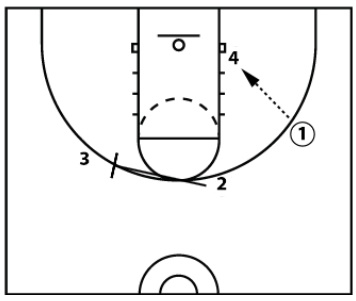
Instructions:
Players can start in these positions.
When coach says, "Go," Player 1 passes the ball to Player 4 in the low post.
From there, the players can make decisions for screening, cutting, and passing based on your motion rules.
However, 4 passes must be made before a shot is taken.
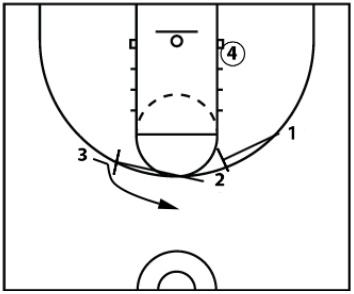
Here is an example of a sequence that follows. The different combinations are endless.
As soon as the ball is passed into 4, Player 2 sets a screen for 3.
After passing, Player 1 heads towards 2's position to set a screen for 3.
This naturally sets up a staggered screen.
Player 3 comes off the screens.
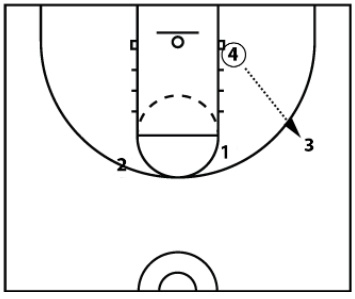
3 is now on the wing.
Player 4 kicks the ball back out to 3.
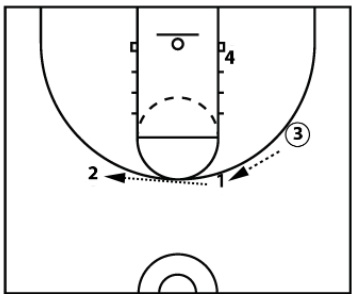
Player 3 passes to 1, who passes to 2.
Now four passes have been reached. A shot can be taken at any time.
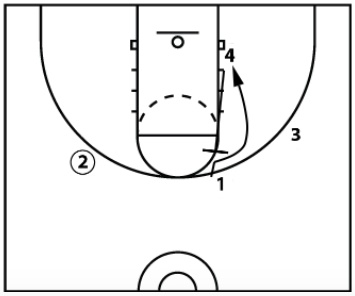
After passing to Player 2, 4 sets a UCLA screen for 1.
Player 1 cuts to the low post.
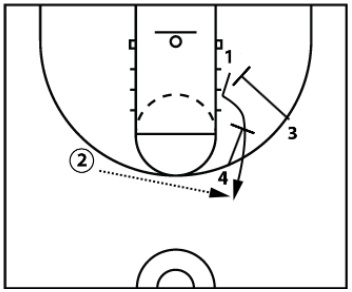
Player 3 sets a screen for 1.
This is followed by another screen by 4 resulting in another staggered screen.
Player 1 now comes off both screens to the slot/guard spot area.
Player 2 passes to Player 1.
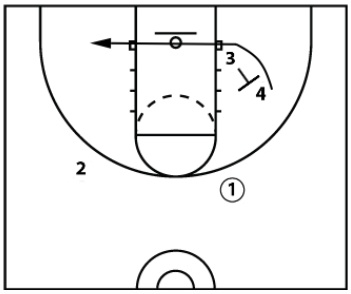
3 then immediately sets a back screen for 4, who cuts under the basket to the weak side.
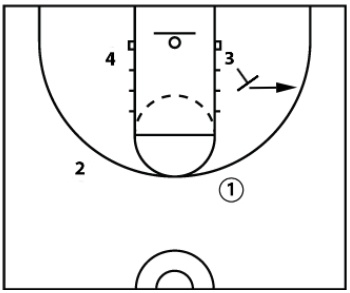
After 4 clears, Player 3 pops out to the 3 point line area.
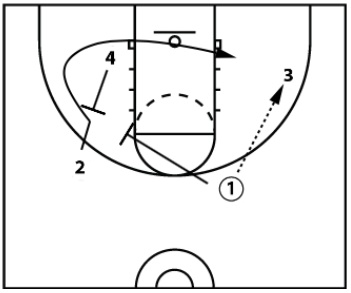
Player 1 passes to 3.
At the same time, Player 4 screens for 2, who cuts underneath the basket.
After passing, Player 1 sets a screen for Player 4.
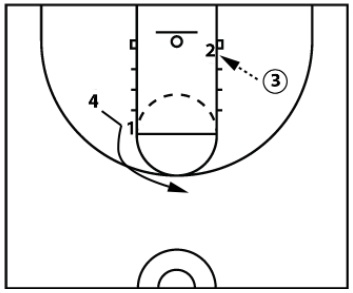
Player 4 comes off 1's screen to the top of the key while Player 3 passes into 2, who's cutting across the lane.
Player 2 shoots.
As a reminder, this is just a sample sequence. Most likely, each sequence will be different.
Drill #2 - 1st Pass Into the Low Post (4v4) - 4 Passes Before Perimeter Jump Shot
It's also vital to practice this situation against live defenders! It doesn't matter if you're a coach who believes in teaching the concepts without a defense present first (like the drill #1) or if you like to start with the live drill first to give players context prior.
You can keep the same regulations with one minor change:
1. There must be at least 4 passes before a perimeter jump shot is taken. Layups are encouraged at any time.
2. Start by passing into the low post.
Hope you can get some Paint Touches working in your favor soon, so you become a high-scoring juggernaut!
RELATED RESOURCES:
Don Kelbick's Attack & Counter Skill Development System - Complements Paint Touches very well because...
Kelbick's simplified approach to teaching high-level post moves will give you the required skill set to develop highly effective players who can score from the post. His 3 pivots and 3 counters are brilliant for teaching pro-level moves in the post and on the perimeter to even beginners.
The "Attack Mentality" that he teaches also results in a ton of dribble drives to the basket resulting in more paint touches.
Even the way he teaches to attack screens incorporates attacking the basket and getting into the paint.
Don Kelbick's Simplified High-Scoring Motion Offense - Also Complements Paint Touches And the Attack & Counter Skill Development System Because...
Don's offensive philosophy is to get lay ups which means attacking the paint. Thus, creating a plethora of easy shots at the rim and high-percentage kick-outs.
Don teaches you a multitude of actions, so you can easily adapt the motion offense for your team and their strengths.
Don also shows how to intertwine his Attack & Counter mentality within a team offense setting which results in a bunch of confident, high IQ players taking high-percentage shots.
The 3 C's Of Post Play & Why Every Player Needs To Practice Post Play
How to Improve Big Man Post Play
To get FREE 5 Drills to Build Your Motion Offense FAST, click the banner below
|
|||||

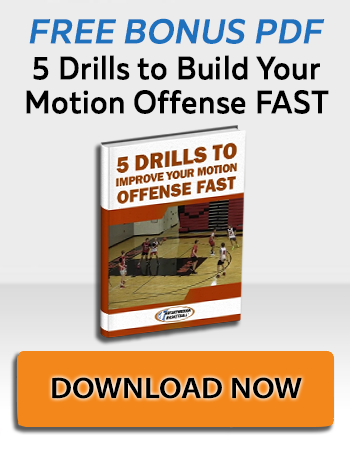


 Facebook (145k Followers)
Facebook (145k Followers) YouTube (152k Subscribers)
YouTube (152k Subscribers) Twitter (33k Followers)
Twitter (33k Followers) Q&A Forum
Q&A Forum Podcasts
Podcasts